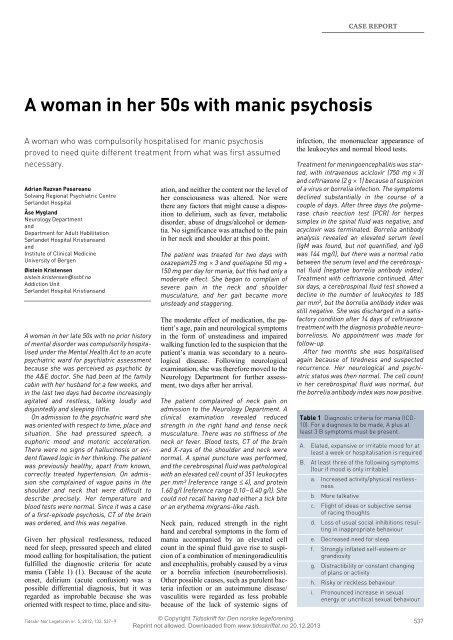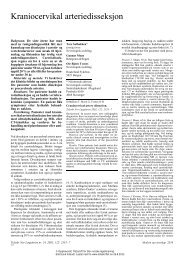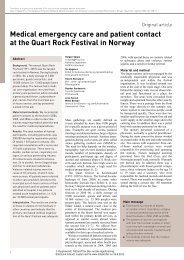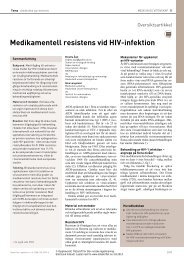Tidsskrift for Den norske legeforening
Tidsskrift for Den norske legeforening
Tidsskrift for Den norske legeforening
Create successful ePaper yourself
Turn your PDF publications into a flip-book with our unique Google optimized e-Paper software.
CASE REPORT<br />
Case report<br />
A woman in her 50s with manic psychosis 537 – 9<br />
A woman who was compulsorily hospitalised <strong>for</strong> manic psychosis<br />
proved to need quite different treatment from what was first assumed<br />
necessary.<br />
Adrian Razvan Pasareanu<br />
Solvang Regional Psychiatric Centre<br />
Sørlandet Hospital<br />
Åse Mygland<br />
Neurology Department<br />
and<br />
Department <strong>for</strong> Adult Habilitation<br />
Sørlandet Hospital Kristiansand<br />
and<br />
Institute of Clinical Medicine<br />
University of Bergen<br />
Øistein Kristensen<br />
oistein.kristensen@sshf.no<br />
Addiction Unit<br />
Sørlandet Hospital Kristiansand<br />
A woman in her late 50s with no prior history<br />
of mental disorder was compulsorily hospitalised<br />
under the Mental Health Act to an acute<br />
psychiatric ward <strong>for</strong> psychiatric assessment<br />
because she was perceived as psychotic by<br />
the A&E doctor. She had been at the family<br />
cabin with her husband <strong>for</strong> a few weeks, and<br />
in the last two days had become increasingly<br />
agitated and restless, talking loudly and<br />
disjointedly and sleeping little.<br />
On admission to the psychiatric ward she<br />
was oriented with respect to time, place and<br />
situation. She had pressured speech, a<br />
euphoric mood and motoric acceleration.<br />
There were no signs of hallucinosis or evident<br />
flawed logic in her thinking. The patient<br />
was previously healthy, apart from known,<br />
correctly treated hypertension. On admission<br />
she complained of vague pains in the<br />
shoulder and neck that were difficult to<br />
describe precisely. Her temperature and<br />
blood tests were normal. Since it was a case<br />
of a first-episode psychosis, CT of the brain<br />
was ordered, and this was negative.<br />
Given her physical restlessness, reduced<br />
need <strong>for</strong> sleep, pressured speech and elated<br />
mood calling <strong>for</strong> hospitalisation, the patient<br />
fulfilled the diagnostic criteria <strong>for</strong> acute<br />
mania (Table 1) (1). Because of the acute<br />
onset, delirium (acute confusion) was a<br />
possible differential diagnosis, but it was<br />
regarded as improbable because she was<br />
oriented with respect to time, place and situation,<br />
and neither the content nor the level of<br />
her consciousness was altered. Nor were<br />
there any factors that might cause a disposition<br />
to delirium, such as fever, metabolic<br />
disorder, abuse of drugs/alcohol or dementia.<br />
No significance was attached to the pain<br />
in her neck and shoulder at this point.<br />
The patient was treated <strong>for</strong> two days with<br />
oxazepam25 mg × 3 and quetiapine 50 mg +<br />
150 mg per day <strong>for</strong> mania, but this had only a<br />
moderate effect. She began to complain of<br />
severe pain in the neck and shoulder<br />
musculature, and her gait became more<br />
unsteady and staggering.<br />
The moderate effect of medication, the patient’s<br />
age, pain and neurological symptoms<br />
in the <strong>for</strong>m of unsteadiness and impaired<br />
walking function led to the suspicion that the<br />
patient’s mania was secondary to a neurological<br />
disease. Following neurological<br />
examination, she was there<strong>for</strong>e moved to the<br />
Neurology Department <strong>for</strong> further assessment,<br />
two days after her arrival.<br />
The patient complained of neck pain on<br />
admission to the Neurology Department. A<br />
clinical examination revealed reduced<br />
strength in the right hand and tense neck<br />
musculature. There was no stiffness of the<br />
neck or fever. Blood tests, CT of the brain<br />
and X-rays of the shoulder and neck were<br />
normal. A spinal puncture was per<strong>for</strong>med,<br />
and the cerebrospinal fluid was pathological<br />
with an elevated cell count of 351 leukocytes<br />
per mm³ (reference range ≤ 4), and protein<br />
1.60 g/l (reference range 0.10 – 0.40 g/l). She<br />
could not recall having had either a tick bite<br />
or an erythema migrans-like rash.<br />
Neck pain, reduced strength in the right<br />
hand and cerebral symptoms in the <strong>for</strong>m of<br />
mania accompanied by an elevated cell<br />
count in the spinal fluid gave rise to suspicion<br />
of a combination of meningoradiculitis<br />
and encephalitis, probably caused by a virus<br />
or a borrelia infection (neuroborreliosis).<br />
Other possible causes, such as purulent bacteria<br />
infection or an autoimmune disease/<br />
vasculitis were regarded as less probable<br />
because of the lack of systemic signs of<br />
infection, the mononuclear appearance of<br />
the leukocytes and normal blood tests.<br />
Treatment <strong>for</strong> meningoencephalitis was started,<br />
with intravenous aciclovir (750 mg × 3)<br />
and ceftriaxone (2 g × 1) because of suspicion<br />
of a virus or borrelia infection. The symptoms<br />
declined substantially in the course of a<br />
couple of days. After three days the polymerase<br />
chain reaction test (PCR) <strong>for</strong> herpes<br />
simplex in the spinal fluid was negative, and<br />
acyclovir was terminated. Borrelia antibody<br />
analysis revealed an elevated serum level<br />
(IgM was found, but not quantified, and IgG<br />
was 144 mg/l), but there was a normal ratio<br />
between the serum level and the cerebrospinal<br />
fluid (negative borrelia antibody index).<br />
Treatment with ceftriaxone continued. After<br />
six days, a cerebrospinal fluid test showed a<br />
decline in the number of leukocytes to 185<br />
per mm 3 , but the borrelia antibody index was<br />
still negative. She was discharged in a satisfactory<br />
condition after 14 days of ceftriaxone<br />
treatment with the diagnosis probable neuroborreliosis.<br />
No appointment was made <strong>for</strong><br />
follow-up.<br />
After two months she was hospitalised<br />
again because of tiredness and suspected<br />
recurrence. Her neurological and psychiatric<br />
status was then normal. The cell count<br />
in her cerebrospinal fluid was normal, but<br />
the borrelia antibody index was now positive.<br />
Table 1 Diagnostic criteria <strong>for</strong> mania (ICD-<br />
10). For a diagnosis to be made, A plus at<br />
least 3 B symptoms must be present.<br />
A. Elated, expansive or irritable mood <strong>for</strong> at<br />
least a week or hospitalisation is required<br />
B. At least three of the following symptoms<br />
(four if mood is only irritable)<br />
a. Increased activity/physical restlessness<br />
b. More talkative<br />
c. Flight of ideas or subjective sense<br />
of racing thoughts<br />
d. Loss of usual social inhibitions resulting<br />
in inappropriate behaviour<br />
e. Decreased need <strong>for</strong> sleep<br />
f. Strongly inflated self-esteem or<br />
grandiosity<br />
g. Distractibility or constant changing<br />
of plans or activity<br />
h. Risky or reckless behaviour<br />
i. Pronounced increase in sexual<br />
energy or uncritical sexual behaviour<br />
© Copyright <strong>Tidsskrift</strong> <strong>for</strong> <strong>Den</strong> <strong>norske</strong> lege<strong>for</strong>ening.<br />
Tidsskr Nor Lege<strong>for</strong>en nr. 5, 2012; 132: 537 – 9 537<br />
Reprint not allowed. Downloaded from www.tidsskriftet.no 20.12.2013
CASE REPORT<br />
Table 2 Somatic causes of secondary mania (modified from (6))<br />
Medication Intoxicants Metabolic disorders Neurological disease<br />
Anabolic steroids Alcohol Anaemia Cerebrovascular disease<br />
(particularly right side)<br />
Antidepressants Amphetamine Cushing’s syndrome Dementia<br />
Benzodiazepines Ecstasy Electrolyte disorder Encephalitis<br />
Captopril Cocaine Hyperthyreosis HIV infection<br />
Enalapril Metamphetamine Influenza Huntingdon’s Disease<br />
Oestrogen Uraemia Neurosyphilis<br />
Calcium<br />
Vitamin deficiency Sydenham’s chorea<br />
(B 12 , niacin)<br />
Levodopa<br />
Traumatic brain injury<br />
Lithium overdose<br />
Tourette’s disease<br />
Termination<br />
Tumor cerebri<br />
of steroids<br />
Steroids<br />
Wilson’s Disease<br />
Sympathicomimetics<br />
These findings dismissed the suspicion of<br />
recurrence of encephalitis, but confirmed<br />
that she had suffered neuroborreliosis. Her<br />
tiredness was regarded as a natural consequence<br />
of suffering encephalitis in combination<br />
with a heavy work load. She was discharged<br />
without specific treatment and was<br />
told she could expect a gradual improvement<br />
of the tiredness. After her discharge<br />
she was followed up by the mental health<br />
service and has been hospitalised once in a<br />
regional psychiatric centre. The reason <strong>for</strong><br />
her admission was suspected depression,<br />
which could not be confirmed. But the patient<br />
was tired because of a heavy work load,<br />
and she was given a short respite stay.<br />
At her last check-up, just over four<br />
months after her first hospitalisation, the<br />
patient appeared to be mastering her life<br />
situation. She was still struggling with the<br />
after-effects of the borreliosis in the <strong>for</strong>m of<br />
headache and fatigue, but was improving.<br />
The diagnosis of definite neuroborreliosis is<br />
based on clinical neurological symptoms<br />
accompanied by the findings of an elevated<br />
number of leukocytes in the cerebrospinal<br />
fluid and a positive borrelia antibody index.<br />
The suspicion of neuroborreliosis in our<br />
patient was maintained in an early phase and<br />
treatment was completed even though the<br />
antibody index was negative in the first two<br />
cerebrospinal fluid tests. The diagnosis was<br />
confirmed after two months, when the antibody<br />
index was positive. The antibody<br />
response is often delayed in borrelia infections<br />
(2). In an early phase of neuroborreliosis<br />
(symptom duration less than six weeks)<br />
the antibody index is negative in about 26 %,<br />
and serum may also be antibody negative.<br />
Our patient was almost symptom-free after<br />
the antibiotics treatment, but after a while<br />
noticed reduced working capacity and tiredness.<br />
Recurrence of the infection was suspected,<br />
but a normal cell count in the cerebrospinal<br />
fluid disproved this. The presence<br />
of antibodies alone did not indicate an active<br />
infection. It has recently been shown that<br />
about 50 % of patients suffer from tiredness<br />
30 months after being treated <strong>for</strong> neuroborreliosis.<br />
Discussion<br />
Mania is a pathological condition characterised<br />
by an elated mood and heightened physical<br />
and mental activity. The mood is not in<br />
keeping with the patient’s situation, and may<br />
vary from carefree joviality to uncontrollable<br />
exhilaration. The exhilaration is accompanied<br />
by increased energy which leads to<br />
overactivity, incessant talking and a reduced<br />
need <strong>for</strong> sleep. Attention cannot be retained,<br />
and the person is easily distracted. Selfesteem<br />
is often inflated, with grandiosity<br />
and excessive self-confidence. Loss of normal<br />
social inhibitions may lead to behaviour<br />
that is frivolous, reckless or inappropriate<br />
and atypical of the person. Mania can be<br />
confused with delirium – a state of confusion<br />
that is characterised by acute onset,<br />
disorientation, visual hallucinations and a<br />
fluctuating level of consciousness (4).<br />
Mania is often part of bipolar disorder<br />
(primary mania), but there may also be<br />
many other causes (secondary mania). The<br />
lifetime prevalence of primary mania is 1 %<br />
(5). The prevalence of secondary mania is<br />
far more difficult to quantify because of<br />
great variation in the different sub-groups.<br />
Secondary mania may be due to medication,<br />
intoxicants, metabolic disturbances or neurological<br />
disease (Table 2) (6). It may be difficult<br />
to identify secondary mania. Advanced<br />
age and somatic symptoms point to<br />
increased suspicion. Elderly adults are in the<br />
danger zone because of a higher prevalence<br />
of medical and neurological diseases. Mania<br />
in the elderly is often incorrectly diagnosed<br />
as dementia with agitation (7).<br />
It is worth noting that mania and other<br />
psychiatric symptoms may be due to neurological<br />
disease even if the image representations<br />
of the brain (CT, SPECT and MRI),<br />
electroencephalography (EEG) and blood<br />
tests are normal. This increases the need <strong>for</strong><br />
a thorough neurological examination, including<br />
spinal fluid analysis, in an early phase.<br />
Spinal fluid tests may be useful <strong>for</strong> identifying<br />
infection (neuroborreliosis, neurosyphilis,<br />
viruses and other infectious agents<br />
that may cause encephalitis), carcinomatosis,<br />
autoimmune diseases and some neurodegenerative<br />
diseases (dementia, Creutzfeldt-Jakob’s<br />
Disease) (8).<br />
Lyme borreliosis is a tick-borne infection<br />
caused by the spiral bacterium Borrelia<br />
burgdoferi. The disease may be localised to<br />
the skin (erythema migrans) or disseminated<br />
to other organ systems, most commonly the<br />
nervous system. Most cases of disseminated<br />
disease that are reported to the Norwegian<br />
Surveillance System <strong>for</strong> Communicable<br />
Diseases (MSIS) come from the counties of<br />
Aust-Agder, Vest-Agder, Vestfold, Telemark,<br />
Sogn og Fjordane and Møre og Romsdal,<br />
but cases have also been reported<br />
further north in Norway (8).<br />
Borrelia infection in the nervous system<br />
(neuroborreliosis) may give rise to a number<br />
of different symptoms that are all accompanied<br />
by an elevated number of mononuclear<br />
leukocytes in the cerebrospinal fluid (7).<br />
The most common symptoms are pain (located<br />
in the neck, back, chest, abdomen or<br />
limbs) due to meningoradiculitis, and facial<br />
paresis. In rare cases, the infection may<br />
attack the central nervous system and cause<br />
confusion, tremor and other involuntary<br />
movements, unsteadiness, single-side paralysis,<br />
aphasia and psychosis. The diagnosis<br />
neuroborreliosis is based on the presence of<br />
neurological symptoms combined with a<br />
concurrent elevated number of lymphocytes<br />
in the cerebrospinal fluid and borrelia antibody<br />
production revealed by a high ratio<br />
between the levels in spinal fluid and serum<br />
(also called positive antibody index). However,<br />
the antibody index in cerebrospinal<br />
fluid is negative in about 26 % of patients in<br />
the early phase (symptom duration less than<br />
six weeks), and serum may also be antibody<br />
negative (9). Fewer than half have a definite<br />
elicited history with a tick bite or erythema<br />
migrans. Antibiotic treatment results in<br />
rapid relief of symptoms and should be started<br />
as soon as there is clinical suspicion of<br />
neuroborreliosis and a high number of lymphocytes<br />
are found in the spinal fluid. The<br />
elapse of a long period from the onset of<br />
symptoms to treatment is associated with a<br />
higher frequency of long-term problems (3,<br />
10). Doxycycline tablets 200 mg daily <strong>for</strong> 14<br />
days is just as effective as intravenous ceftriaxone<br />
in cases of affection of the peripheral<br />
nervous system (facial paresis and<br />
meningoencephalitis), but <strong>for</strong> encephalitis<br />
many would recommend intravenous ceftriaxone<br />
twice daily <strong>for</strong> 14 days (11).<br />
538<br />
© Copyright <strong>Tidsskrift</strong> <strong>for</strong> <strong>Den</strong> <strong>norske</strong> lege<strong>for</strong>ening.<br />
Tidsskr Nor Lege<strong>for</strong>en nr. 5, 2012; 132<br />
Reprint not allowed. Downloaded from www.tidsskriftet.no 20.12.2013
CASE REPORT<br />
Our patient suffered from mania caused<br />
by borrelia encephalitis. Various psychiatric<br />
symptoms of neuroborreliosis have been<br />
described (12, 13), but the onset of a manic<br />
pathological picture has not previously been<br />
described in Europe. A case history from<br />
North America describes a patient who<br />
developed a bipolar-like syndrome with<br />
both depression and mania as the first symptoms<br />
of borrelia infection (14). The many<br />
manifestations of neuroborreliosis indicate<br />
that it should be regarded as a possible differential<br />
diagnosis and cerebrospinal fluid<br />
should be tested on the first manifestation of<br />
psychotic illness, particularly when it is<br />
accompanied by pain.<br />
Conclusion<br />
In the case of first-episode psychosis, including<br />
mania, a neurological cause should be<br />
considered even if the image representation<br />
of the brain and the blood tests are normal.<br />
Neuroborreliosis and other encephalitic<br />
diseases are diagnosed by means of spinal<br />
fluid tests, and rapidly applied treatment<br />
improves the prognosis.<br />
The patient has consented to the publication of the<br />
article.<br />
Adrian Razvan Pasareanu (born 1974)<br />
Registrar Specialist at Solvang Regional<br />
Psychiatric Centre, Sørlandet Hospital<br />
The author has completed the ICMJE <strong>for</strong>m<br />
and declares no conflicts of interest.<br />
Åse Mygland (born 1958)<br />
Specialist in neurology and Senior Consultant<br />
at the Neurology Department and Department<br />
<strong>for</strong> Adult Habilitation, Sørlandet Hospital Kristiansand.<br />
Adjunct Professor at the Institute<br />
of Clinical Medicine, University of Bergen.<br />
The author has completed the ICMJE <strong>for</strong>m<br />
and declares no conflicts of interest.<br />
Øistein Kristensen (born 1945)<br />
Specialist in psychiatry and Senior Consultant<br />
at the Addiction Unit, Sørlandet Hospital, Kristiansand.<br />
The author has completed the ICMJE <strong>for</strong>m<br />
and declares no conflicts of interest.<br />
Litteratur<br />
1. World Health Organization. The ICD-10 Classification<br />
of mental and behavioural disorders. Clinical<br />
descriptions and diagnostic guidelines. Genève:<br />
World Health Organization, 1992.<br />
2. Ljøstad U, Skarpaas T, Mygland A. Clinical usefulness<br />
of intrathecal antibody testing in acute Lyme<br />
neuroborreliosis. Eur J Neurol 2007; 14: 873 – 6.<br />
3. Eikeland R, Mygland A, Herlofson K et al. European<br />
neuroborreliosis: quality of life 30 months after<br />
treatment. Acta Neurol Scand 2011; 124: 349 – 54.<br />
4. Malt UF, Retterstøl N, Dahl AA. Lærebok i psykiatri.<br />
Oslo: Gyldendal Akademisk, 2005.<br />
5. Merikangas KR, Akiskal HS, Angst J et al. Lifetime<br />
and 12-month prevalence of bipolar spectrum<br />
disorder in the National Comorbidity Survey replication.<br />
Arch Gen Psychiatry 2007; 64: 543 – 52.<br />
6. McDonald WM. Epidemiology, etiology, and treatment<br />
of geriatric mania. J Clin Psychiatry 2000;<br />
61 (Suppl 13): 3 – 11.<br />
7. Brooks JO 3rd, Hoblyn JC. Secondary mania in<br />
older adults. Am J Psychiatry 2005; 162: 2033 – 8.<br />
8. Deisenhammer F, Egg R, Giovannoni G et al. EFNS<br />
guidelines on disease-specific CSF investigations.<br />
Eur J Neurol 2009; 16: 760 – 70.<br />
9. Folkehelseinstituttet. MSIS-statistikk.<br />
www.msis.no (1.6.2011).<br />
10. Ljøstad U, Mygland A. Remaining complaints<br />
1 year after treatment <strong>for</strong> acute Lyme neuroborreliosis;<br />
frequency, pattern and risk factors. Eur<br />
J Neurol 2010; 17: 118 – 23.<br />
11. Mygland Å, Ljøstad U, Fingerle V et al. EFNS<br />
guidelines on the diagnosis and management<br />
of European Lyme neuroborreliosis. Eur J Neurol<br />
2010; 17: 8 – 16, e1 – 4.<br />
12. Fallon BA, Kochevar JM, Gaito A et al. The underdiagnosis<br />
of neuropsychiatric Lyme disease in<br />
children and adults. Psychiatr Clin North Am 1998;<br />
21: 693 – 703, viii.<br />
13. Markeljevic J, Sarac H, Rados M. Tremor, seizures<br />
and psychosis as presenting symptoms in a patient<br />
with chronic lyme neuroborreliosis (LNB). Coll<br />
Antropol 2011; 35 (suppl 1): 313 – 8.<br />
14. Fallon BA, Nields JA, Parsons B et al. Psychiatric<br />
manifestations of Lyme boreliosis. J Clin Psychiatry<br />
1993; 54: 263 – 8.<br />
Received 10 June 2011, first revision submitted<br />
16 September 2011, approved 29 September 2011.<br />
Medical editor: Erlend Aasheim.<br />
Comment<br />
Demanding diagnostics – important diagnosis 539 – 40<br />
There is little probability of a healthy patient<br />
who has not previously had psychiatric<br />
problems becoming manic in her late 50s<br />
without there being an organic reason <strong>for</strong> it.<br />
The somatic diagnostics may be demanding.<br />
It is necessary to examine possible neurological,<br />
metabolic, medicinal and intoxicant-related<br />
causes. The patient had early<br />
symptoms such as impaired strength and<br />
unsteady gait which pointed in a neurological<br />
direction. Many conditions do not show up on<br />
a CT or, less commonly, on an MRI either. A<br />
lumbar puncture should be per<strong>for</strong>med early.<br />
Antibodies develop slowly in borreliosis,<br />
and serological tests are frequently negative,<br />
particularly in the early stages of the disease<br />
(1). The incubation period may be long, so<br />
that in many cases the patient is not aware of<br />
exposure. The diagnostic challenges can be<br />
illustrated by the fact that the disease is also<br />
called «the new great imitator». Neuroborreliosis<br />
has become the most frequently occurring<br />
neuroinfectious condition in Europe<br />
where the source of infection is a vector (2).<br />
The prevalence is increasing, probably partly<br />
due to vegetation changes and a milder<br />
climate.<br />
The most common psychiatric symptoms<br />
are tiredness and depression, but panic<br />
attacks, schizophrenia-like symptoms and<br />
hallucinations may also occur (2).<br />
The patient was hospitalised two months<br />
later on suspicion of depression, but the diagnosis<br />
was not confirmed. However, she was<br />
suffering from tiredness, a common sequela<br />
that can last a long time. After completion of<br />
treatment, regional hypoactivity with respect<br />
to blood supply and metabolism was also<br />
found, particularly in the temporal and parietal<br />
lobes and in the limbic system (3).<br />
In addition to neurological and psychiatric<br />
symptoms, skin manifestations in particular<br />
are common, but the heart and limbs<br />
may also be affected.<br />
Although the prognosis is normally good,<br />
a sneaking development may mean that<br />
more areas of the brain may be affected<br />
be<strong>for</strong>e diagnosis and treatment, resulting in<br />
a protracted course <strong>for</strong> the disease.<br />
The treatment may be difficult because<br />
the bacterium has developed many defence<br />
mechanisms. The treatment is often successful<br />
if it is applied early, but a chronic infection<br />
may be difficult to treat (1).<br />
Early diagnosis and treatment is important<br />
with a view to shortening both the course of<br />
the active disease and the restitution period.<br />
Since the symptoms presented can be so<br />
variable, it is useful <strong>for</strong> rare cases, such as the<br />
present one, to be published.<br />
Øivind Ekeberg<br />
oivind.ekeberg@ous-hf.no<br />
Department of Acute Medicine<br />
Oslo University Hospital, Ullevål<br />
Øivind Ekeberg (born 1945) Specialist in psychiatry<br />
and supervisor in psychodynamic psychotherapy.<br />
Senior Consultant in psychiatry,<br />
Department of Acute Medicine, Oslo University<br />
Hospital, Ulleval. Adjunct Professor in medical<br />
behavioural science, Institute of Basal Medical<br />
Sciences, University of Oslo. He works as both<br />
clinician and researcher, particularly with<br />
suicidal behaviour, psychotraumatology and<br />
mental reactions in connection with somatic<br />
disease.<br />
The author has completed the ICMJE <strong>for</strong>m and<br />
declares no conflicts of interest.<br />
>>><br />
© Copyright <strong>Tidsskrift</strong> <strong>for</strong> <strong>Den</strong> <strong>norske</strong> lege<strong>for</strong>ening.<br />
Tidsskr Nor Lege<strong>for</strong>en nr. 5, 2012; 132: 539 – 40 539<br />
Reprint not allowed. Downloaded from www.tidsskriftet.no 20.12.2013
















